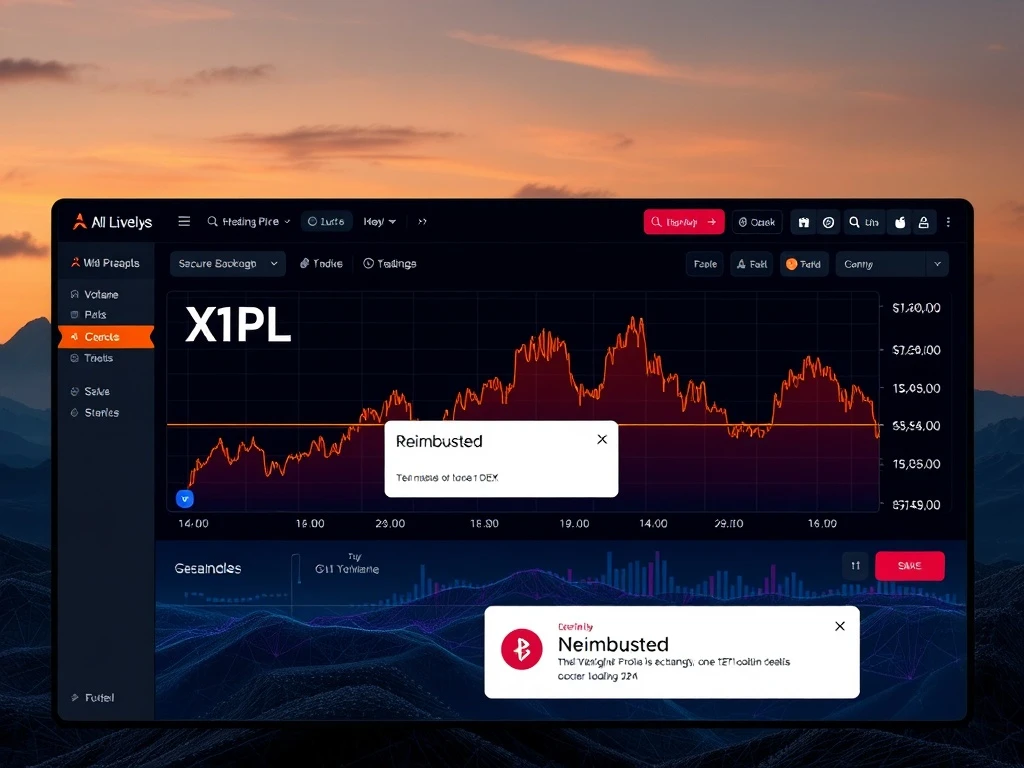Aster DEX: Unprecedented Rebound After XPL Perpetual Glitch and $100 Billion Volume Milestone

The volatile world of decentralized finance (DeFi) often presents both remarkable opportunities and unforeseen challenges. Recently, the Aster DEX demonstrated this duality, swiftly addressing a critical glitch while simultaneously achieving an unprecedented milestone in DeFi trading volume. This article delves into the recent XPL perpetual market incident and Aster’s remarkable growth, offering crucial insights into the evolving landscape of decentralized derivatives.
Aster DEX Addresses XPL Perpetual Glitch and Ensures User Reimbursement
BNB Chain derivatives decentralized exchange (DEX), Aster, successfully completed reimbursements for traders affected by a glitch in its Plasma (XPL) perpetual market. This issue briefly drove prices significantly above standard market levels. According to Abhishek Pawa, CEO of Web3 agency AP Collective, the problem originated from a misconfigured index hard-coded at $1. Consequently, when the mark price cap was lifted before a fix, XPL futures on Aster surged to nearly $4. Meanwhile, other trading venues maintained a price of approximately $1.3. This sudden price discrepancy, therefore, triggered unexpected liquidations and abnormal fee charges, causing significant losses for numerous users.
Aster responded with remarkable speed and transparency. On Friday, the platform quickly assured its users that all funds remained safe. They also promised full compensation for any losses incurred due to the incident. Just hours later, the DEX announced that reimbursements had been fully distributed to affected accounts. Shortly thereafter, Aster deployed another round of compensation, specifically covering trading and liquidation fees. This decisive action underscores Aster’s commitment to user protection and platform integrity, especially critical in the fast-paced environment of decentralized finance.
Aster DEX Achieves Unprecedented $100 Billion DeFi Trading Volume
While addressing the XPL glitch, Aster also sustained a period of rapid growth this week. This surge drove overall perpetual DEX volumes to an astounding $104 billion on Friday. This marked the fourth consecutive day of record daily highs for the platform. DefiLlama data clearly illustrated Aster’s dominance, recording $46 billion in volume on Friday alone. This figure significantly dwarfed its competitors, Lighter and Hyperliquid, which also showed strong performances with nearly $19 billion and $17 billion, respectively. Aster’s volume surge began earlier in the week, specifically on Wednesday. It surpassed its strongest competitor, Hyperliquid, with a trading volume nearing $25 billion. At the time of writing, CoinGlass showed Aster’s open interest stood at an impressive $1.15 billion. This sustained growth indicates a significant shift in market dynamics and increasing user adoption for Aster.
Understanding the Plasma (XPL) Token and Its Ecosystem
The XPL token serves as the native cryptocurrency of Plasma, a layer-1 network specifically optimized for stablecoins. Plasma offers several compelling features within the DeFi ecosystem. For instance, it provides zero-fee Tether (USDT) transfers, a crucial advantage for users prioritizing cost-efficiency. Furthermore, the network boasts EVM compatibility, allowing for seamless integration of smart contracts and broader developer access. Plasma also benefits from significant backing. Venture capitalist Peter Thiel and Tether CEO Paolo Ardoino are notable supporters. The network has recently garnered substantial traction within the DeFi space. On Friday, Ethena’s USDe lending markets on Aave, facilitated via Plasma, reached their initial $1 billion supply caps within hours of launching. This rapid uptake signals robust demand for the synthetic dollar stablecoin on the Plasma network, further solidifying XPL’s integral role.
Navigating Risks and Community Concerns Amidst Crypto Liquidations
Despite Aster’s impressive metrics and rapid growth, community members have voiced legitimate concerns regarding potential risks for traders. One community member, for example, expressed skepticism over the reported trading volume on Aster. They specifically brought up the possibility of airdrop incentives artificially inflating platform usage. Another user urged traders to exercise caution, advising them to cash out on their trades. They highlighted the ease with which one can lose money at this stage of market development. These concerns underscore the inherent volatility and risks associated with high-leverage trading on perpetual DEXs. Traders must conduct thorough due diligence and understand the mechanisms behind potential crypto liquidations. It remains crucial for platforms to maintain transparency and for users to manage their risk effectively in this dynamic environment. Responsible trading practices are always paramount.
The Future Trajectory of Perpetual DEXs and Aster’s Position
The recent events surrounding Aster, including both its technical challenges and unprecedented growth, highlight the evolving landscape of perpetual DEX platforms. These decentralized exchanges are becoming increasingly central to the broader DeFi ecosystem, offering sophisticated trading instruments without traditional intermediaries. Aster’s swift resolution of the XPL glitch and its commitment to user reimbursement establish a strong precedent for trust and reliability in a sector often criticized for its experimental nature. However, the community’s concerns about volume incentives and trading risks remain valid. As perpetual DEXs continue to innovate and attract more users, robust security measures, transparent operations, and clear communication will be paramount. Aster’s ability to maintain its growth trajectory while addressing these critical aspects will determine its long-term success and influence within the competitive decentralized finance space.









